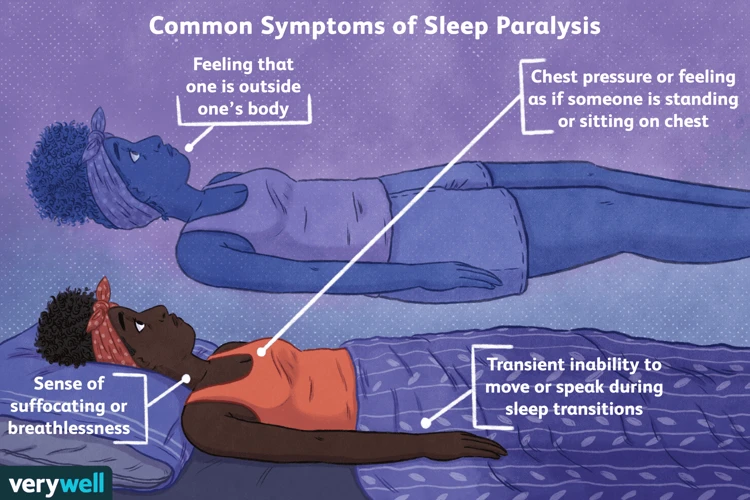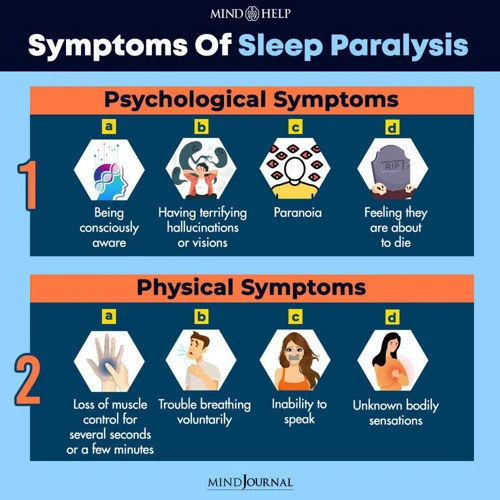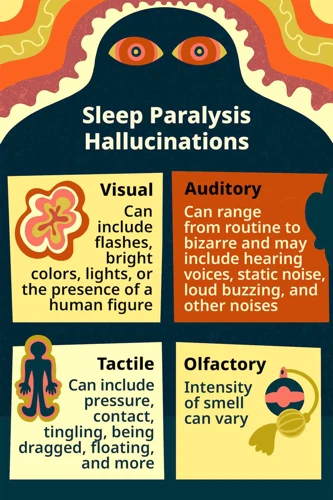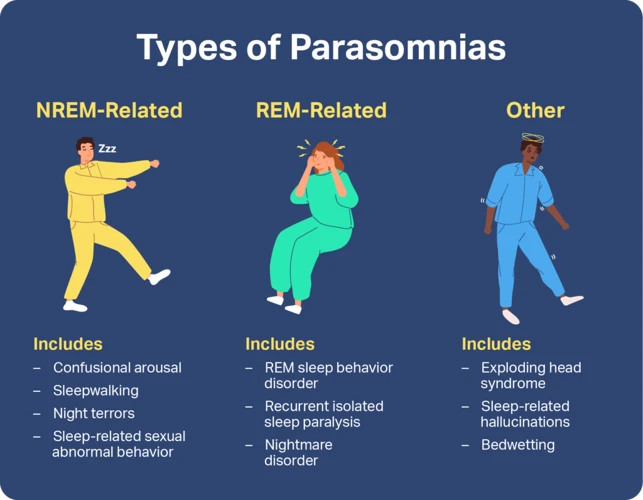Sleep paralysis is a phenomenon that has puzzled people for centuries, with many experiencing it without fully understanding what it is or how to manage it. It can be a distressing and frightening experience, leaving individuals feeling helpless and vulnerable. In this article, we will delve into the physical symptoms of sleep paralysis and how to recognize and manage them, as well as exploring methods for preventing and treating this condition. So, if you’ve ever woken up unable to move or speak, feeling a weight on your chest and experiencing vivid hallucinations, read on to unravel the mysteries of sleep paralysis.
What is Sleep Paralysis?

Sleep paralysis is a phenomenon in which an individual is unable to move or speak while falling asleep or waking up. It is often referred to as a sleep disorder and can be quite frightening for those who experience it. The physical symptoms of sleep paralysis are very real and can feel very intense.
Definition: Sleep paralysis is a type of parasomnia or unwanted behavior that occurs during sleep. It is characterized by the inability to move or speak during the transition between waking and sleeping.
Causes: The exact cause of sleep paralysis is not well understood, but there are several factors that appear to contribute to its occurrence. Sleep deprivation, irregular sleep patterns, and certain medications or substances have been linked to experiencing sleep paralysis. Additionally, sleep paralysis may be associated with other sleep disorders such as narcolepsy or sleep apnea.
Sleep paralysis can be a particularly distressing experience for those who suffer from it. However, understanding what causes it can help individuals better manage their symptoms and seek appropriate medical intervention if necessary.
Definition
Sleep paralysis is a frightening and perplexing phenomenon characterized by an inability to move or speak upon waking up or falling asleep. It can be a terrifying experience, leaving individuals feeling paralyzed and vulnerable. However, it’s important to understand the definition of this condition in order to recognize and manage its effects. Strong curiosity and a desire to learn more about sleep paralysis definition is only natural, especially for those who have experienced this condition.
Causes
Sleep paralysis can be a perplexing and distressing experience that disrupts an individual’s normal sleep patterns. The phenomenon can be caused by a variety of factors, some of which are listed in the table below.
| Cause | Description |
|---|---|
| Sleep Deprivation | Sleep paralysis is often experienced by those who are sleep deprived or fatigued. Lack of sleep and REM sleep disruption can increase the likelihood of sleep paralysis. |
| Irregular Sleep Schedule | Irregular sleep patterns, such as those experienced by shift workers or those suffering from insomnia, can trigger episodes of sleep paralysis. |
| Stress and Anxiety | Physical or emotional stress may cause sleep paralysis. Anxiety, depression, and post-traumatic stress disorder have all been linked to an increased risk of sleep paralysis. |
| Genetic Predisposition | There is some evidence to suggest that genetics may play a role in the development of sleep paralysis. Some families have been found to have a higher incidence of sleep paralysis compared to others. |
| Substance Abuse | Drug and alcohol abuse can increase the frequency and intensity of sleep paralysis episodes. Some medications, such as those used to treat anxiety and depression, may also trigger sleep paralysis. |
| Other Sleep Disorders | Sleep paralysis may be a symptom of other sleep disorders, such as narcolepsy or sleep apnea. |
While these causes do not guarantee that an individual will experience sleep paralysis, they do increase the likelihood of experiencing this phenomenon. It is important to consult with a medical professional if one experiences frequent episodes of sleep paralysis, as it may be a symptom of an underlying sleep disorder.
Physical Symptoms of Sleep Paralysis

Sleep paralysis is a phenomenon that can be both frightening and unsettling, and physical symptoms of sleep paralysis can be particularly distressing. During an episode of sleep paralysis, a person may experience a range of physical sensations that can leave them feeling helpless and trapped. These symptoms are caused by the fact that the body is unable to move while the mind is still awake, but why and how these symptoms occur is still a topic of debate within the scientific community.
Feeling of Pressure or Weight on the Chest
One of the most common physical symptoms of sleep paralysis is a feeling of pressure or weight on the chest. This can make it difficult to breathe and can create a sense of suffocation. This sensation is often described as feeling like someone or something is sitting on the chest, making it nearly impossible to move or even take a deep breath.
Inability to Move or Speak
Another physical symptom of sleep paralysis is the inability to move or speak. While a person’s mind may be fully conscious, their body will not respond to their commands, leaving them paralyzed and immobilized. This can create a sense of helplessness and fear, as the person is unable to fight back or move away from any perceived danger.
Hallucinations
Hallucinations are also common during episodes of sleep paralysis. These can take many forms, including visual, auditory, or tactile. A person may see or hear things that are not really there, or feel like they are being touched or moved by an unseen force. These hallucinations can be particularly vivid and realistic, adding to the fear and disorientation of the experience.
Breathing Difficulties
Sleep paralysis can also cause breathing difficulties, which can make the experience even more frightening. When the body is paralyzed, the muscles responsible for breathing may also be affected, causing shallow or irregular breathing patterns. This can lead to a sense of panic, as the person struggles to take in enough air to sustain their body.
Rapid Heartbeat
Finally, another physical symptom of sleep paralysis is a rapid heartbeat. This can be caused by the fear and panic associated with the experience, or by the fact that the body is unable to regulate its own heart rate. This can cause the person to feel like their heart is racing, making them feel even more anxious and agitated.
The physical symptoms of sleep paralysis can be very distressing, but it is important to remember that the experience is not dangerous in itself. By understanding the symptoms and learning how to manage and prevent sleep paralysis, it is possible to reduce the frequency and severity of these episodes and get a better night’s sleep.
Feeling of Pressure or Weight on the Chest
One of the most common physical manifestations of sleep paralysis is the sensation of an oppressive force pressing down on the chest. This experience is often accompanied by a feeling of suffocation, tightness, or constriction. It can be an incredibly frightening sensation, leaving individuals feeling helpless and trapped in their own bodies. Understanding this symptom and its underlying causes can help individuals better recognize and manage their sleep paralysis experiences.
Inability to Move or Speak
One of the most prominent physical symptoms of sleep paralysis is the inability to move or speak. During this state, the individual may feel as though their body is frozen in place, and they are unable to make any voluntary movements or vocalize their thoughts.
This sensation is often accompanied by a feeling of intense fear or panic, as the person is aware of their inability to move or communicate. It’s important to note, however, that this sensation is a natural part of the body’s sleep cycle and not an indication of a broader health issue.
If you experience this symptom during sleep paralysis, it’s essential to remain calm and remind yourself that the state will pass in due course. Trying to force your body to move or vocalize during this state can exacerbate feelings of fear and anxiety and may prolong the duration of the episode.
Instead, try to focus on slowing your breathing and using soothing mental imagery to relax your body, which may help you transition out of sleep paralysis more quickly. Some individuals also find it helpful to concentrate on moving a single body part or wiggling their fingers or toes, as this can help break the paralysis and signal to the brain that it’s time to wake up.
Remember, the inability to move or speak during sleep paralysis is a temporary sensation that will pass in due course. With patience and self-care, you can learn to manage and overcome this symptom with ease.
Hallucinations
One of the most disturbing and vivid physical symptoms of sleep paralysis is encountering hallucinations. The hallucinations experienced during sleep paralysis can range from mild to extremely terrifying and can potentially cause a great deal of mental stress and anxiety.
It is common for individuals experiencing sleep paralysis to encounter both auditory and visual hallucinations. Auditory hallucinations may include hearing strange sounds or voices, while visual hallucinations may manifest as seeing supernatural beings or feeling the presence of someone or something in the room.
Some of the most common hallucinations associated with sleep paralysis include shadow people, aliens, and ghosts. It’s important to note that these hallucinations may not be accurate representations of an individual’s beliefs or fears, and instead may be random and unpredictable.
Hallucinations during sleep paralysis have been linked to a number of factors including high levels of stress, sleep deprivation, and even genetics. During sleep paralysis, the body is in a state of heightened awareness, and this can cause the brain to interpret information incorrectly, leading to the manifestation of hallucinations.
It’s important to recognize that while sleep paralysis and hallucinations may be distressing and disorienting, they are not indicative of any serious medical condition. Individuals who experience frequent sleep paralysis or are significantly troubled by it should speak with their healthcare provider to explore possible treatment options.
Table: Common Hallucinations Associated with Sleep Paralysis
| Hallucination Type | Description |
|---|---|
| Shadow People | Dark humanoid figures that are often seen standing by the bed or moving around the room. |
| Aliens | Extraterrestrial beings that are often described as having large eyes and abducting the individual. |
| Ghosts | Manifestations of deceased individuals or spirits that are often associated with feelings of fear or dread. |
Breathing Difficulties
During episodes of sleep paralysis, people may experience difficulty breathing, which can be a frightening and unsettling sensation. This symptom can lead to a feeling of being smothered or suffocated.
There are different ways in which breathing difficulties can manifest during sleep paralysis. Some people may feel like they are being choked or strangled, while others may experience shortness of breath or difficulty inhaling or exhaling. These sensations can be extremely distressing and can exacerbate feelings of panic or fear.
It is important to note that while breathing difficulties are a common symptom of sleep paralysis, they may also be indicative of other medical conditions such as asthma or sleep apnea. If these symptoms persist outside of sleep paralysis episodes, it is important to seek medical intervention.
During an episode of sleep paralysis, it can be helpful to focus on regulating breathing patterns to mitigate feelings of panic or suffocation. Encouraging deep, slow breaths in and out can help to calm the nervous system and bring a sense of control back to the individual experiencing the episode. Additionally, remedying the underlying causes of sleep paralysis, such as poor sleep hygiene, can help to reduce or eliminate breathing difficulties during episodes.
If breathing difficulties during sleep paralysis become unbearable or begin to affect an individual’s quality of life, medical or therapeutic intervention may be necessary. Healthcare professionals may recommend treatments such as relaxation techniques, medication, or cognitive-behavioral therapy to help manage the symptomatology of sleep paralysis.
Rapid Heartbeat
One of the physical symptoms of sleep paralysis is a sudden increase in heart rate, also known as rapid heartbeat. This can be a very distressing symptom for those experiencing it. The following are some of the reasons why rapid heartbeat may occur during sleep paralysis:
- Fight or flight response: When we experience fear, the body releases adrenaline which causes the heart rate to increase. During sleep paralysis, the feeling of being trapped or unable to move can trigger the fight or flight response, leading to an increase in heart rate.
- Anxiety: Anxiety and panic attacks can also cause an increase in heart rate. Sleep paralysis can be a result of anxiety and if someone experiences sleep paralysis frequently, it can increase their anxiety levels, leading to a rapid heartbeat.
- Abnormal sleep patterns: People with sleep disorders such as sleep apnea or insomnia tend to have an irregular sleep pattern. This can lead to fragmented sleep which can cause the heart to beat faster during the REM sleep stage, when sleep paralysis occurs.
It is common for individuals experiencing sleep paralysis to feel their heart pounding in their chest. However, it is important to note that while this symptom can be distressing, it poses no physical harm to the individual. To manage this symptom and reduce anxiety during sleep paralysis, individuals can try the following:
- Breathing exercises: Slow and deep breathing can help calm the body and decrease heart rate during sleep paralysis.
- Visualization exercises: Imagine a peaceful scene or visualize positive thoughts to calm the mind during sleep paralysis and reduce the heart rate.
- Relaxation techniques: Practicing relaxation techniques such as muscle relaxation and meditation during the day and before bedtime may decrease overall anxiety levels and decrease the likelihood of experiencing rapid heartbeat during sleep paralysis.
While rapid heartbeat during sleep paralysis is common and not harmful, individuals who experience frequent or severe episodes of sleep paralysis coupled with rapid heartbeat should seek medical advice. It may be indicative of an underlying sleep disorder or anxiety disorder that requires further investigation and treatment.
Recognizing the Physical Symptoms of Sleep Paralysis

It is essential to recognize the physical symptoms of sleep paralysis to manage and prevent it effectively. Sleep paralysis is a temporary inability to move or speak during the onset of sleep or awakening. During this experience, an individual may also feel pressure on their chest, have hallucinations or difficulty breathing.
What to Look Out For: If you are experiencing sleep paralysis, you may find it challenging to move or speak, which can be distressing. Look out for any feeling of pressure or weight on your chest, hallucinations, difficulty breathing, or a rapid heartbeat. These physical symptoms can often be alarming and unsettling.
When to Seek Medical Intervention: Although sleep paralysis can occur as a once-off experience, it can become persistent and disruptive to an individual’s sleep routine. If you have a prolonged experience of sleep paralysis or it is affecting your quality of life by creating anxiety or depression, it is essential to seek medical intervention. A doctor may prescribe medication or recommend alternative therapies to manage your condition and improve your sleep quality.
Recognizing and identifying the powerful physical symptoms of sleep paralysis is crucial for proper diagnosis and management. If you experience any of these symptoms, including chest pressure, hallucinations, breathing difficulties, or a rapid heartbeat, it is essential to seek medical advice. By being aware of these symptoms, you can also take proactive steps to manage sleep paralysis effectively.
What to Look Out For
As sleep paralysis can be a frightening experience, it is important to be aware of the physical symptoms associated with it. It is crucial to pay attention to any unusual sensations, such as pressure on the chest or difficulty breathing. Additionally, being unable to move or speak during sleep paralysis can also be a telltale sign. Another common symptom is experiencing vivid hallucinations, which can be disturbing or even terrifying. By recognizing the physical symptoms, individuals can better understand and address their experience of sleep paralysis.
When to Seek Medical Intervention
It is important to recognize the physical symptoms of sleep paralysis and know when to seek medical intervention. While sleep paralysis itself is not a dangerous condition, underlying health issues can cause or exacerbate the symptoms. Here are some signs that you may need to consult a healthcare professional:
| Signs to Look Out For | Possible Underlying Causes |
|---|---|
| Frequent or Severe Episodes of Sleep Paralysis | May indicate an underlying sleep disorder, such as narcolepsy or REM sleep behavior disorder. |
| Physical Injuries | In rare cases, people with sleep paralysis may injure themselves while trying to move during an episode. |
| Other Symptoms | Sleep paralysis can be associated with other conditions, such as anxiety or depression, and may require medical treatment. |
If you experience any of these signs, it is important to speak with a healthcare professional. Diagnosis and treatment of underlying conditions can help manage your sleep paralysis symptoms and improve your overall quality of life.
How to Manage Sleep Paralysis

Sleep paralysis can be a frightening experience, but there are several strategies to manage it. Sleep hygiene is an important first step in managing sleep paralysis. It involves establishing and maintaining a regular sleep schedule, avoiding caffeine and alcohol before bedtime, and creating a comfortable sleep environment.
Additionally, stress management techniques can help control your sleep paralysis. Mindfulness-based stress reduction techniques such as meditation, yoga, or tai chi can be effective. They help to control stress and anxiety levels which may trigger sleep paralysis.
Another option for managing sleep paralysis is to use a sleep paralysis alarm clock. This can be set to go off during a period of paralysis or just before sleep paralysis usually occurs. The alarm can wake you up, allowing you to move or change positions, which can help alleviate sleep paralysis.
It’s important to remember that managing sleep paralysis requires patience and persistence. Trying different strategies may be necessary before finding what works best for you. Additionally, incorporating some simple lifestyle changes can also help alleviate symptoms associated with sleep paralysis.
If you experience frequent sleep paralysis episodes that persist despite your best efforts, it may be time to discuss medical treatment options with your healthcare provider. They can help to diagnose underlying conditions or prescribe medications to manage symptoms.
The goal of managing sleep paralysis is to help reduce the frequency and intensity of episodes, and to alleviate any associated anxiety or discomfort. With the right strategies and support, it is possible to manage sleep paralysis and enjoy a good night’s sleep.
Sleep Hygiene
Maintaining good sleep hygiene can go a long way in managing and preventing sleep paralysis. However, many people are not aware of the necessary practices that constitute good sleep hygiene. Fortunately, there are several simple steps that can be taken to ensure that you are optimizing the quality of your sleep, such as establishing a regular sleep schedule, avoiding caffeine and alcohol before bed, and creating a comfortable sleep environment. In this section, we will explore the role of sleep hygiene in managing sleep paralysis and provide practical tips for improving your sleep habits.
Stress Management
Stress management is an important factor in managing sleep paralysis as it has been linked to triggering symptoms. There are various techniques that can be used to manage stress and reduce the risk of experiencing sleep paralysis. Here are some stress management techniques that can be helpful:
- Meditation: Meditation is a powerful tool that can be helpful in reducing stress levels. By focusing on your breathing and quieting your mind, you can create a sense of calm that can help reduce your risk of experiencing sleep paralysis.
- Exercise: Exercise is a great way to manage stress levels and reduce the risk of sleep paralysis. Exercise releases endorphins, which are natural stress-fighters that can help you feel calmer and more relaxed.
- Journaling: Writing down your thoughts and feelings can be a helpful way of managing stress. By putting your thoughts onto paper, you can gain a greater sense of perspective and feel less overwhelmed by stress.
- Deep Breathing: Deep breathing exercises can be helpful in reducing stress levels. By taking slow, deep breaths, you can calm your mind and reduce the risk of experiencing sleep paralysis.
- Aromatherapy: Aromatherapy is the use of scents and essential oils to promote relaxation and reduce stress. Lavender, chamomile, and ylang-ylang are all known to promote relaxation and reduce stress levels.
- Time Management: Proper time management can be helpful in reducing stress levels. By creating a schedule and breaking down tasks into manageable chunks, you can reduce the feeling of being overwhelmed and promote a sense of calm in your daily life.
By incorporating these stress management techniques into your daily routine, you can reduce your risk of experiencing sleep paralysis and promote overall health and well-being. Remember that stress management is not a one-size-fits-all solution and it may take some experimentation to find the techniques that work best for you.
Sleep Paralysis Alarm Clocks
For individuals who experience frequent sleep paralysis episodes, sleep paralysis alarm clocks may provide a helpful solution. These specialized alarm clocks are designed to help disrupt the sleep cycle in order to prevent sleep paralysis episodes from occurring.
One type of sleep paralysis alarm clock works by using vibrations or light stimuli to wake the individual up during REM sleep, the stage of sleep in which sleep paralysis most commonly occurs. By interrupting this stage of sleep, the likelihood of experiencing sleep paralysis is reduced.
Another type of sleep paralysis alarm clock utilizes a technique known as “scheduled awakenings”. This involves setting an alarm to wake up the individual before a typical episode of sleep paralysis would occur, with the aim of disrupting the sleep cycle and preventing the episode from happening.
It is important to note, however, that while sleep paralysis alarm clocks may be effective for some individuals, they are not a guaranteed solution for everyone. Additionally, disrupting the sleep cycle can potentially have negative impacts on overall sleep quality and may not be a sustainable long-term solution.
As with any sleep-related issue, it is recommended to consult with a medical professional before implementing a new sleep aid or treatment.
Preventing Sleep Paralysis

Sleep paralysis can be a frightening and uncomfortable experience. While treatment options are available, preventing sleep paralysis from occurring can be just as important. By taking a few simple steps, individuals can greatly reduce the likelihood of experiencing sleep paralysis.
Creating a Bedtime Routine
One of the most effective ways to prevent sleep paralysis is to create a bedtime routine. Going to bed and waking up at the same time every day can help regulate the body’s sleep-wake cycle. Additionally, incorporating relaxing activities before bed, such as reading a book or taking a warm bath, can help calm the mind and prepare the body for sleep.
Sleeping in a Comfortable Environment
Ensuring a comfortable sleep environment can also help prevent sleep paralysis. It is important to choose a mattress and pillow that support the body’s natural alignment and to keep the bedroom at a comfortable temperature. Additionally, minimizing external noise and light sources can help promote restful sleep.
Meditation and Relaxation Techniques
Meditation and relaxation techniques, such as deep breathing and visualization exercises, can also help prevent sleep paralysis. These techniques can help reduce stress and anxiety, which have been linked to increased episodes of sleep paralysis.
Incorporating some or all of these preventive measures can significantly reduce the likelihood of experiencing sleep paralysis. By promoting healthy sleep habits and reducing stress, individuals can take control of their sleep and enjoy a restful and peaceful night’s rest.
Creating a Bedtime Routine
Establishing a consistent bedtime routine can be an effective strategy for preventing sleep paralysis. A bedtime routine involves a set of activities or rituals that signal to the brain and body that it is time to wind down and prepare for sleep. By creating a conducive and calming bedtime routine, you can increase the likelihood of falling asleep faster and staying asleep for longer periods. This, in turn, reduces the likelihood of experiencing sleep paralysis symptoms. In this section, we will explore some practical tips for creating a bedtime routine that may help mitigate the physical symptoms of sleep paralysis.
Sleeping in a Comfortable Environment
One way to prevent sleep paralysis is to make sure that you are sleeping in a comfortable environment. This means that your bedroom should be conducive to a good night’s sleep. Creating a comfortable sleeping environment can involve a number of factors, such as:
| Factor | Explanation |
|---|---|
| Temperature | Make sure that your bedroom is at a comfortable temperature. A room that is too hot or too cold can disrupt your sleep and promote sleep paralysis. |
| Noise level | Reduce any noise levels that may disturb your sleep. Consider using earplugs, a white noise machine or a soundproofing system if you live in a noisy area. |
| Lighting | Ensure that your bedroom is dark, as this will promote the production of melatonin, the hormone that helps you sleep. Use curtains, window shades, or an eye mask if your bedroom is bright at night. |
| Mattress and pillow | Invest in a good quality mattress and pillow that fit your body and sleeping habits. A comfortable and supportive mattress can prevent aches and pains, while a pillow that supports your neck and head can prevent snoring and sleep apnea. |
| Bedding | Make sure your bedding is fresh, clean, and comfortable. Choose bed sheets that are soft and breathable, and blankets that are the right weight and warmth for the season. |
By ensuring a comfortable sleeping environment, you can decrease the likelihood of experiencing sleep paralysis. It is important to remember that everyone’s sleeping preferences are unique, so experiment and adjust your bedroom environment to find what works best for you.
Meditation and Relaxation Techniques
One effective way to prevent sleep paralysis is through meditation and relaxation techniques. By practicing mindfulness and relaxation, you can reduce stress and anxiety levels, which can trigger sleep paralysis.
Here are some tips for incorporating meditation and relaxation into your bedtime routine:
- Practice deep breathing exercises before going to bed. Breathe in slowly and deeply, hold for a few seconds, and then exhale slowly.
- Try progressive muscle relaxation, which involves tensing and releasing different muscle groups in your body. Start with your toes and work your way up to your head.
- Use aromatherapy, such as lavender oil, to help promote relaxation.
- Listen to calming music or guided meditations to help clear your mind and ease into sleep.
- Engage in a relaxation practice, such as yoga or tai chi, which can also help improve overall physical and mental health.
Remember, incorporating these techniques into your routine takes time and practice. Try implementing one or two techniques at a time and see what works best for you. With patience and consistency, you may find that you experience better sleep and a reduction in sleep paralysis episodes.
Treatment Options for Sleep Paralysis
There are several treatment options available for sleep paralysis. However, it is important to note that the effectiveness of the treatment may vary depending on the underlying cause of the sleep disorder.
Medical Treatment
In cases where sleep paralysis is linked to an underlying sleep disorder such as narcolepsy, treatment of the underlying condition may help alleviate sleep paralysis symptoms. Medications such as stimulants or antidepressants may be prescribed by a doctor to help regulate sleep patterns and reduce the frequency and intensity of sleep paralysis episodes.
Therapeutic Treatment
Therapeutic treatment options such as cognitive-behavioral therapy (CBT) may be effective in managing sleep paralysis symptoms. CBT helps individuals develop coping mechanisms and strategies to reduce the negative effects of sleep paralysis. This type of therapy may also address underlying anxiety and stress that can contribute to sleep paralysis.
Other therapeutic treatments such as hypnotherapy, meditation, and yoga may also help reduce the frequency and intensity of sleep paralysis episodes. These treatments help improve overall sleep quality and promote relaxation and stress reduction.
It is important to consult with a healthcare professional before starting any treatment for sleep paralysis. A healthcare professional can help identify the underlying cause of the sleep disorder and provide appropriate treatment options.
Medical Treatment
When it comes to addressing sleep paralysis, seeking medical treatment can be a viable option for those who experience persistent or severe symptoms. Medical treatment may involve a range of interventions, from medication to lifestyle adjustments, that aim to alleviate the physical and psychological distress associated with this sleep disorder. While medical treatment may not cure sleep paralysis outright, it can provide much-needed relief and improve overall sleep quality. In this section, we’ll explore some of the medical treatment options available and the potential benefits and drawbacks of each.
Therapeutic Treatment
For individuals experiencing chronic sleep paralysis, therapeutic treatments can be an effective way to manage the condition. Here are a few therapeutic approaches that have been found helpful:
- Cognitive-behavioral therapy (CBT): This form of therapy focuses on changing negative thought patterns and behaviors that may contribute to sleep paralysis. A therapist can work with the individual to identify triggers or stressors that may be exacerbating the condition and develop coping mechanisms to manage these stressors more effectively.
- Muscle relaxation techniques: Practicing techniques such as progressive muscle relaxation or deep breathing exercises can help alleviate anxiety and promote relaxation, which may in turn reduce the likelihood of experiencing sleep paralysis. Yoga and meditation can also be helpful.
- Virtual reality therapy: This form of therapy involves exposing individuals to virtual reality environments that simulate the experience of sleep paralysis. The goal is to desensitize individuals to the fear and anxiety associated with the experience, thereby reducing the frequency and severity of sleep paralysis episodes.
- Hypnosis: Hypnotherapy can be used to help individuals enter a relaxed state and address psychological factors that may contribute to sleep paralysis. It can also be used to help individuals develop coping mechanisms for when they experience an episode.
While there is no cure for sleep paralysis, therapeutic treatments can be helpful in managing the condition and reducing its impact on an individual’s daily life. It is important to work with a licensed professional to determine the best course of treatment for each individual’s unique needs.
Conclusion
In conclusion, sleep paralysis is a frightening experience that can leave individuals feeling helpless and vulnerable. Understanding the physical symptoms of sleep paralysis is the first step towards managing and preventing it. The feeling of pressure or weight on the chest, inability to move or speak, hallucinations, breathing difficulties, and rapid heartbeat are all common symptoms of sleep paralysis that can be distressing to the individual experiencing them.
It is important to recognize the symptoms and seek medical intervention if necessary, especially if the physical symptoms of sleep paralysis are accompanied by other sleep disorders or underlying medical conditions. In some cases, medical treatment or therapeutic treatment may be necessary to manage and prevent sleep paralysis.
However, there are also many strategies that can be employed to manage and prevent sleep paralysis, such as practicing good sleep hygiene, stress management techniques, and using sleep paralysis alarm clocks. By creating a bedtime routine, sleeping in a comfortable environment, and engaging in meditation and relaxation techniques, individuals can reduce their risk of experiencing sleep paralysis.
In summary, sleep paralysis can be a frightening and distressing experience, but by recognizing the physical symptoms, seeking appropriate medical care if necessary, and employing effective management and prevention strategies, individuals can find relief and improve their overall sleep health.
Frequently Asked Questions
What is the difference between sleep paralysis and a nightmare?
A nightmare is a bad dream that causes fear or anxiety, while sleep paralysis is the inability to move or speak while waking up or falling asleep.
Can anyone experience sleep paralysis?
Yes, sleep paralysis can happen to anyone, although it is more common in people with certain sleep disorders or those with a family history of the condition.
Is sleep paralysis dangerous?
No, sleep paralysis is not dangerous in and of itself. However, it can cause significant distress and anxiety in those who experience it.
What causes sleep paralysis?
Sleep paralysis can be caused by a variety of factors, including sleep deprivation, irregular sleep schedules, certain medications or substances, and underlying sleep disorders such as narcolepsy.
How long does sleep paralysis usually last?
Episodes of sleep paralysis typically last a few seconds to a few minutes, although they can feel much longer to the person experiencing them.
What is the treatment for sleep paralysis?
Treatment for sleep paralysis may involve addressing underlying sleep disorders or implementing lifestyle changes to promote healthy sleep habits. In some cases, therapy or medication may be necessary.
Can meditation help with sleep paralysis?
Yes, practicing meditation and relaxation techniques may be helpful for reducing the frequency or severity of sleep paralysis episodes.
Is sleep paralysis genetic?
There is some evidence to suggest that sleep paralysis may have a genetic component, as it tends to run in families.
Can sleeping on your back cause sleep paralysis?
Sleeping on your back may increase the likelihood of experiencing sleep paralysis, although there is no definitive evidence to support this theory.
Why does sleep paralysis sometimes involve hallucinations?
Hallucinations during sleep paralysis are thought to be caused by disruption to the normal sleep cycle, which can lead to a state of semi-consciousness that blurs the line between waking and dreaming.









